Kitchari or Kitcharee (pronounced kich-uh-ree) is a traditional Ayurvedic cleanser made with mung dal and basmati rice. This authentic kitchari recipe has been passed down from my great grandmother, grandmother and my mom. It's vegan, gluten-free, nutrient-rich, follows traditional Ayurvedic principles, is made in one pot, and a great savory "cleanse" meal to add to your list of go-to foods for eating clean!
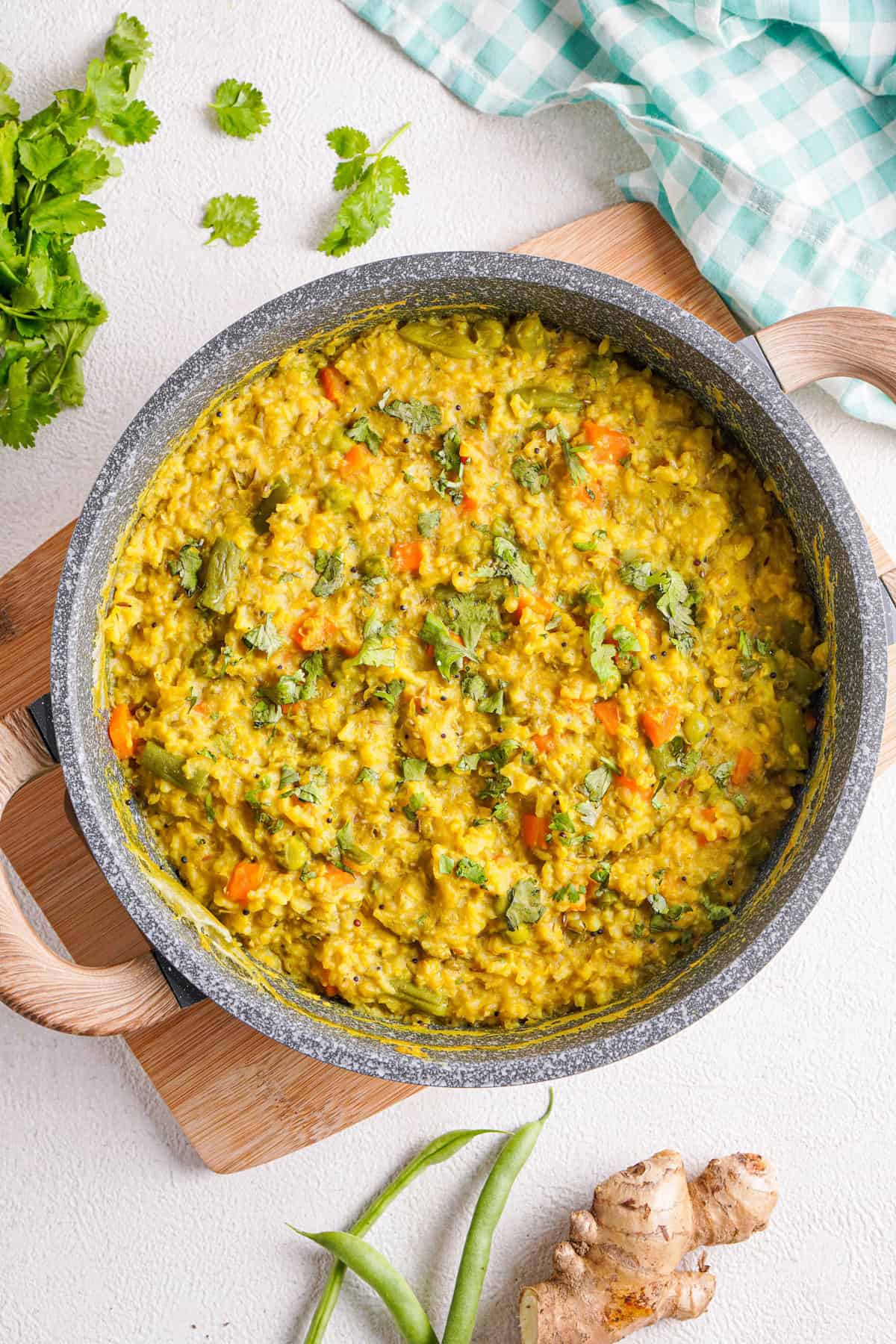
This post contains helpful tips and tricks! If you're in a rush, please use the "Jump to Recipe" below!
⭐ What is kitchari?
Kitchari is an Ayurvedic dish made with rice and moong dal, and a range of vegetables and spices. On rainy days, my mother would roast moong dal (or mung) dal, and cook it in a pressure cooker along with rice and vegetables.
Kitchari is also called khichdi, bisibelabath, sukhpawani, pongal in different parts of India and has its origins in Sanskrit (khiccā, meaning ‘a dish made with rice and pulses’)
The combination of rice, lentils and spices aids digestion, and nourishes your body with all the essential nutrients. It is considered tri-doshic. So, this is one of the most common staple dishes in many homes across India!
💭 Why you'll love this authentic kitchari recipe
- Authentic, Ayurvedic recipe: This kitchari recipe was passed down from my grandmother. I only use ingredients that follow Ayurvedic principles. I do not use additives like garlic (which remove some of the Ayurvedic properties). To read more about this, scroll down to the ingredients and notes section.
- Versatile, great for meal-prep: I've always had kitchari for breakfast, but it can easily make a great lunch, or dinner. It's also versatile in the types of veggies you can add!
- Naturally vegan and minimal ingredients: Though kitchari is served with a dollop of ghee, the recipe is vegan as written. You are welcome to add ghee if you wish!
- Detox / digestion friendly: The softness of this dish makes it easy for digestion, and can work as a "detox" since it is also highly nutritious (in both proteins and other nutrients!)
📋 Ingredients and notes
You'll need mung dal (or moong dal), basmati rice, coconut oil, vegetables of your choice, and a few basic Indian spices (mustard seeds, cumin seeds, turmeric, ground coriander, and ginger paste) to make this dish. I use fresh cilantro as garnish.

Notes and substitutions
- Moong dal is the small yellow lentil found inside the green mung bean (also called split mung beans). Since one of the primary benefits is digestion, the lentils are preferred over beans. In a pinch, you can substitute this with red lentils found in your grocery store.
- Basmati rice is used in this recipe since it's most commonly available, but you can substitute this with quinoa, amaranth, brown rice, red rice, or spelt (and maintain tridoshic properties)
- Homemade kitchari spice mix consists of fresh ginger, turmeric, cumin seeds, coriander and mustard seeds. We use both ground and whole spices to enhance flavor and for detoxifying and anti-inflammatory properties. You can also add warming spices like asafetida, fennel seeds, and fenugreek for more flavor.
- Vegetable medley is highly customizable - I typically use a mix of seasonal vegetables and almost always have carrots and peas. You can use fresh or frozen veggies. I omit onions and garlic in this recipe so it can be tri-doshic, but you can add these in if you're not following the principles strictly.
📖 How to make kitchari
Wash the rice and lentils
Sift through the rice and lentils with your hands to see if there are any minor impurities in there, then wash both rice and my mung dal separately at least 2-3 times. This is done to remove the excess starch in the rice and clean the lentils.
This is especially important if you're using a polished rice like basmati (which is not the typical variant used in India). Wash until the water runs mostly clear.
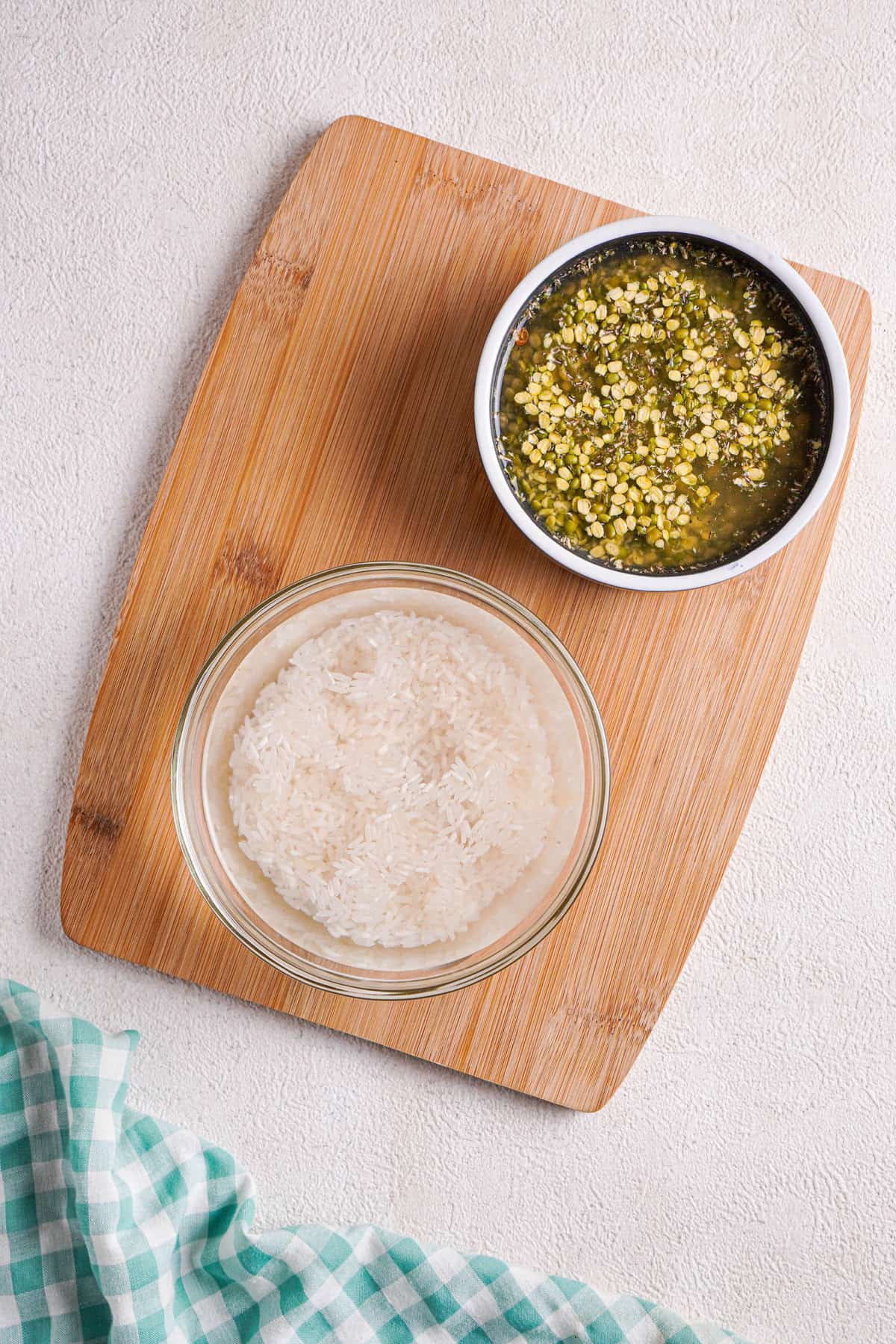
Toast the spices to release their flavors
Heat vegetable or coconut oil (or fat of choice) in a large skillet or pot (with a lid) over medium heat.
Then, add the mustard seeds, cumin seeds, and ground coriander to the oil and stirring occasionally, until fragrant, about a minute.
Finally, add minced ginger and turmeric and cook for about 15-20 seconds.
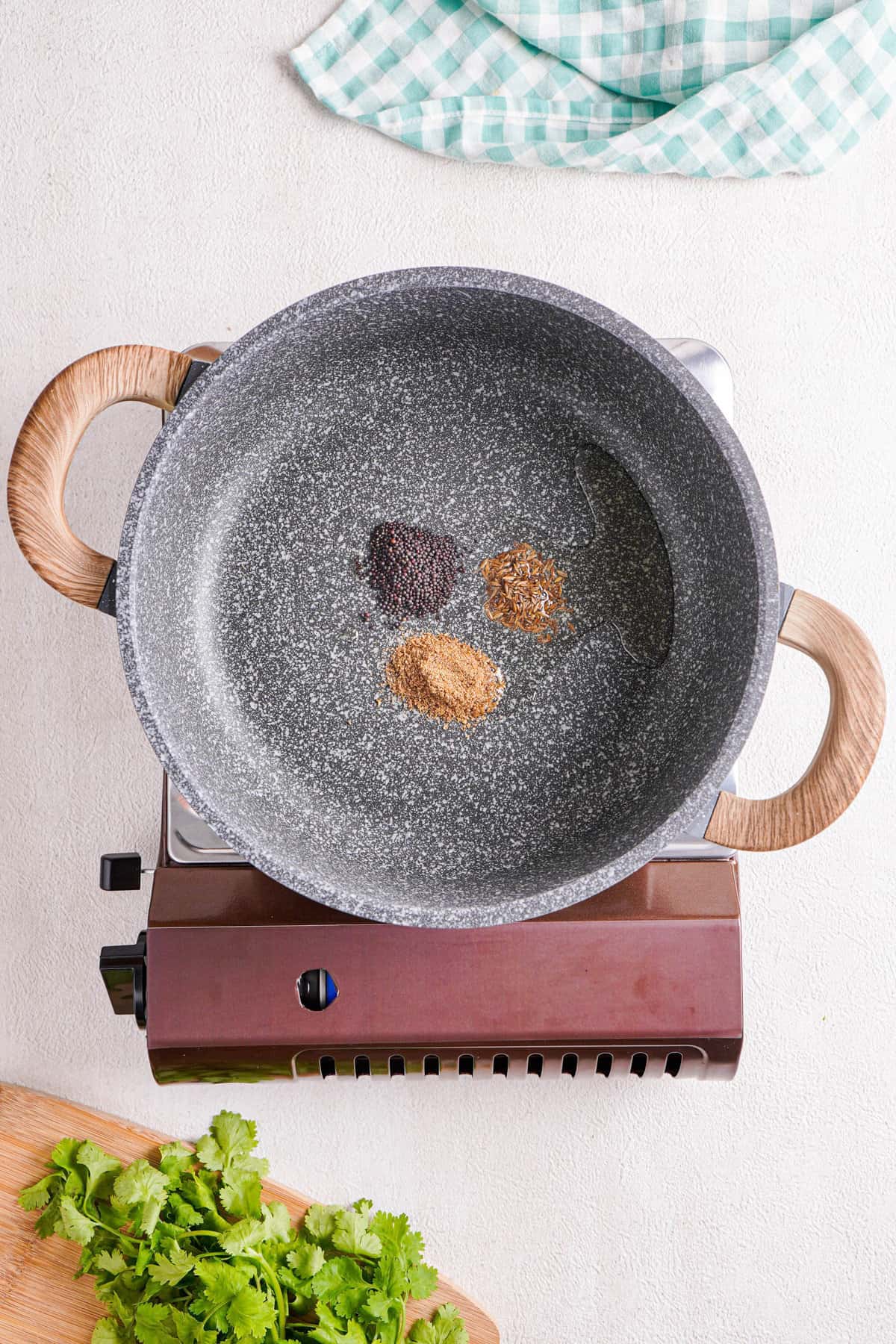
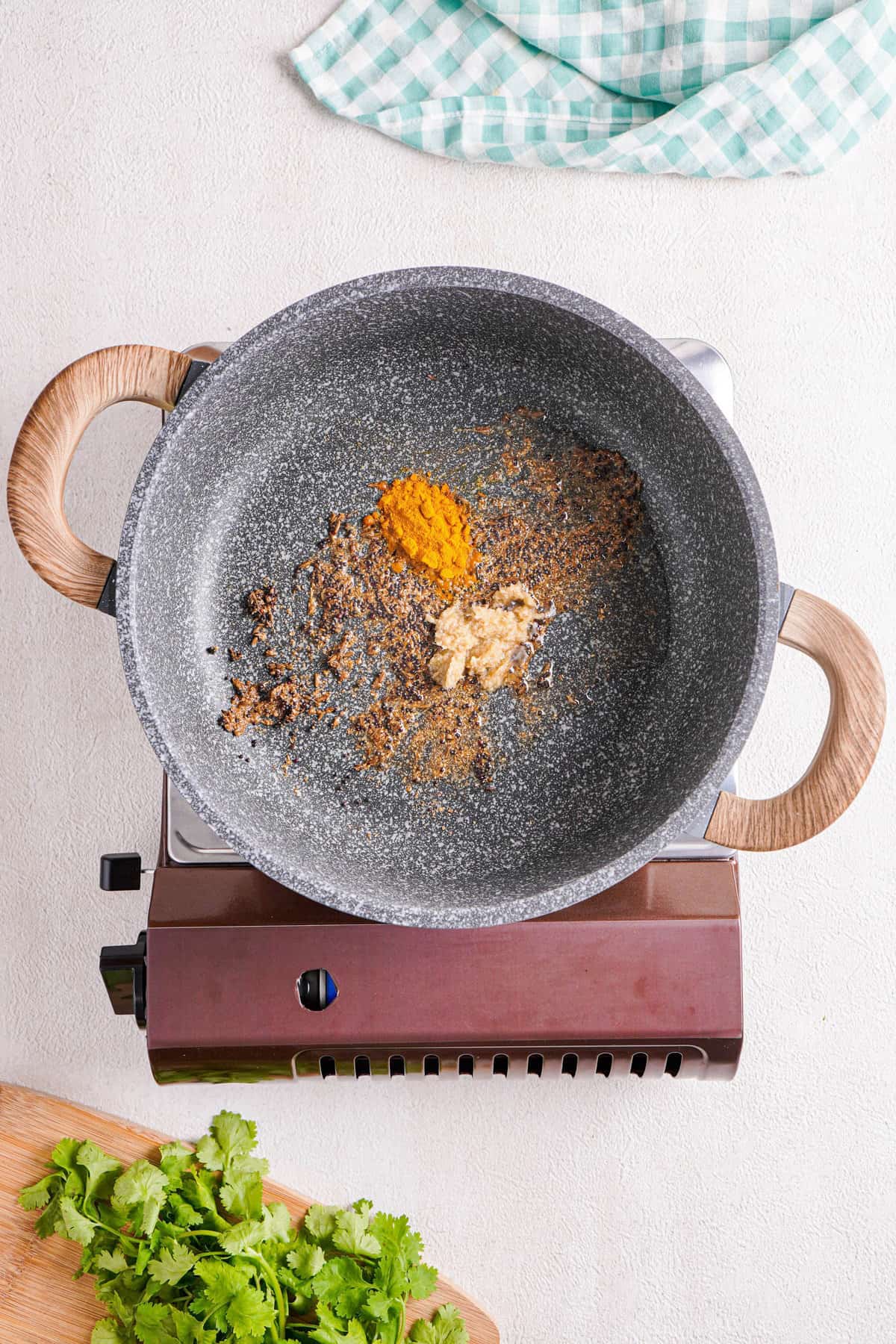
Cook rice, lentils and vegetables with water
Add the the vegetables and sauté quickly. Then, add the rice and vegetables along with water and a pinch of salt. Bring all of this to a boil.
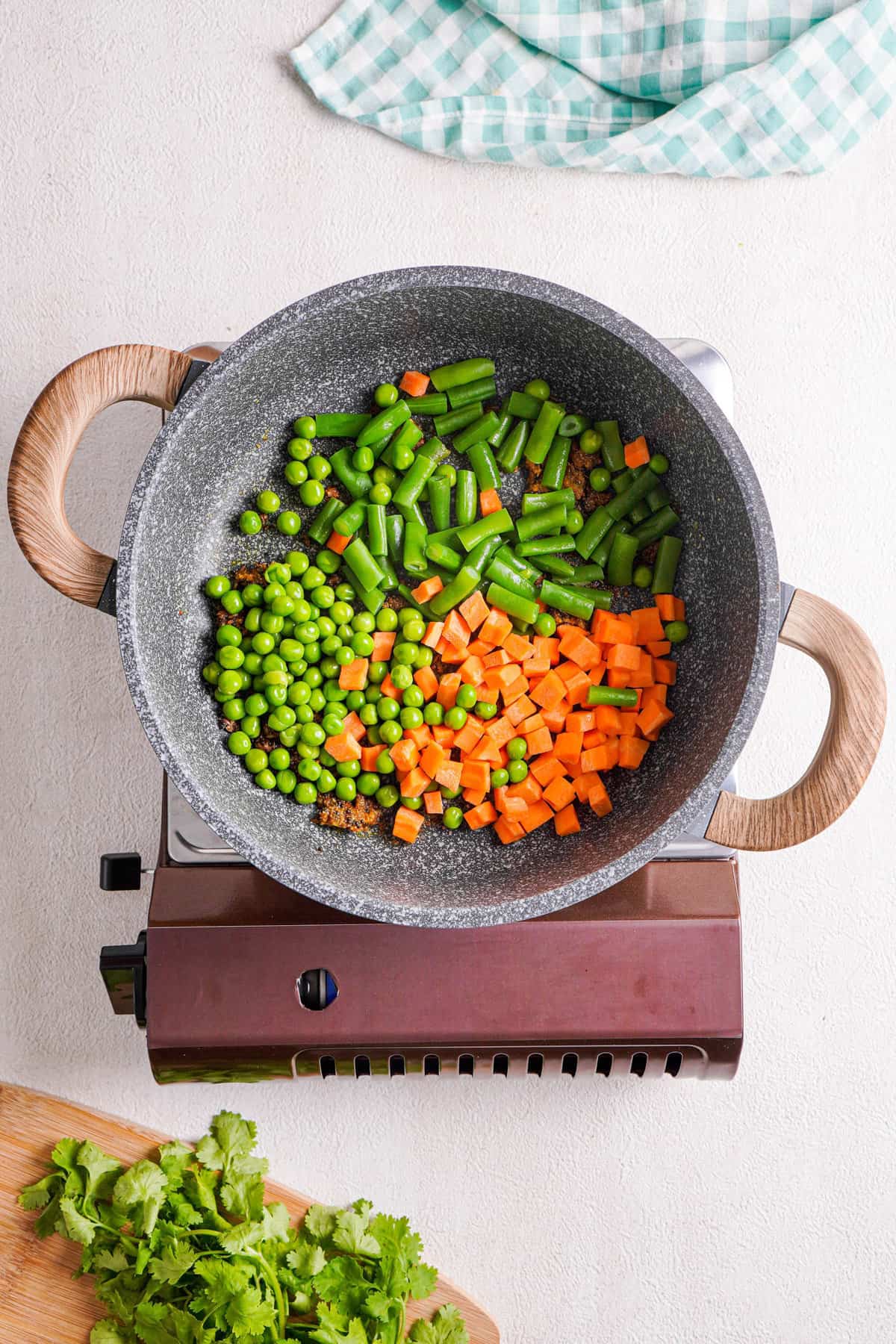
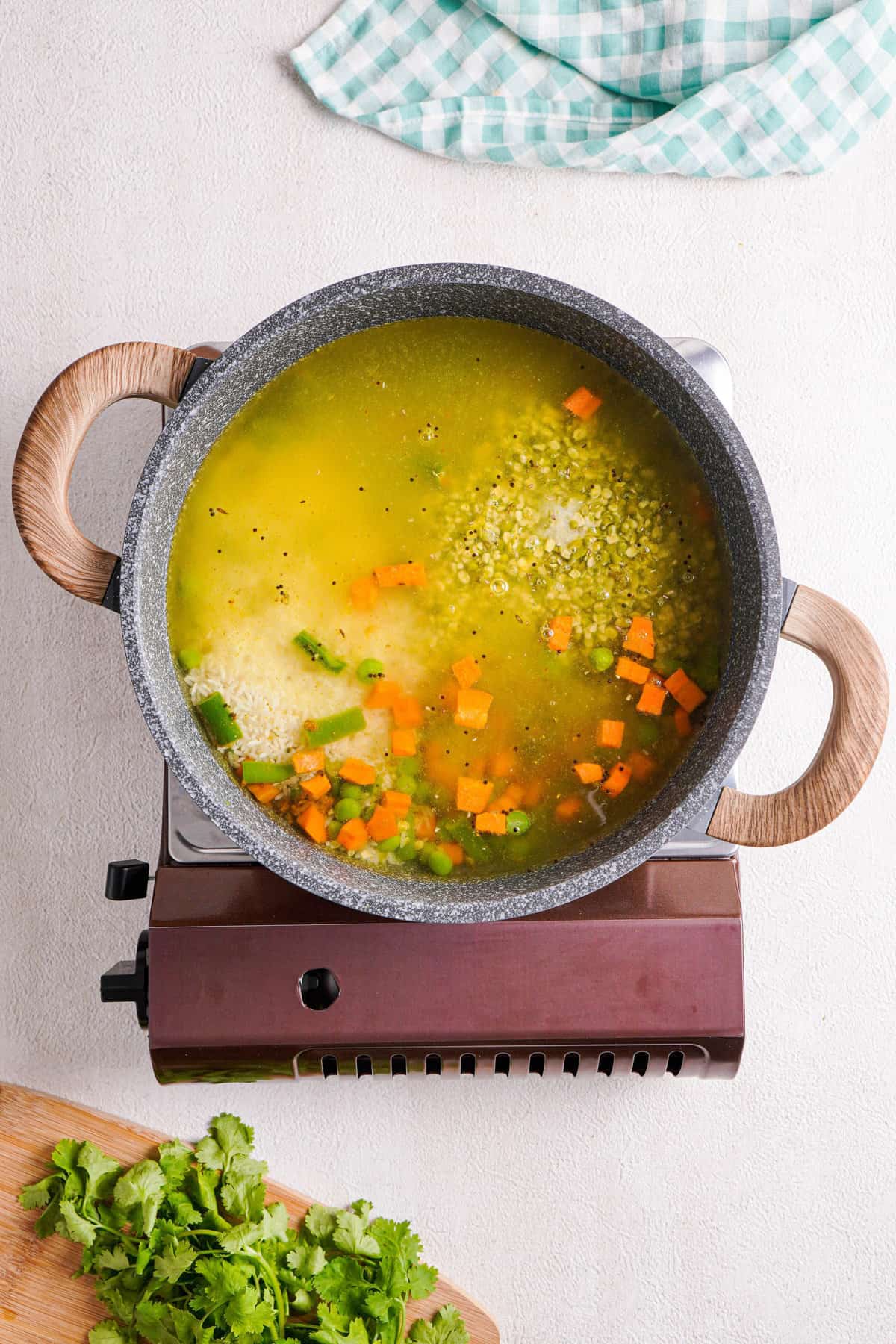
Then, reduce the heat and cook covered, on low heat, for about 30 minutes.
Note that this yields a kitchari that has somewhere between a risotto and porridge-like consistency. If you want it more discrete, I suggest reducing the water by half a cup.
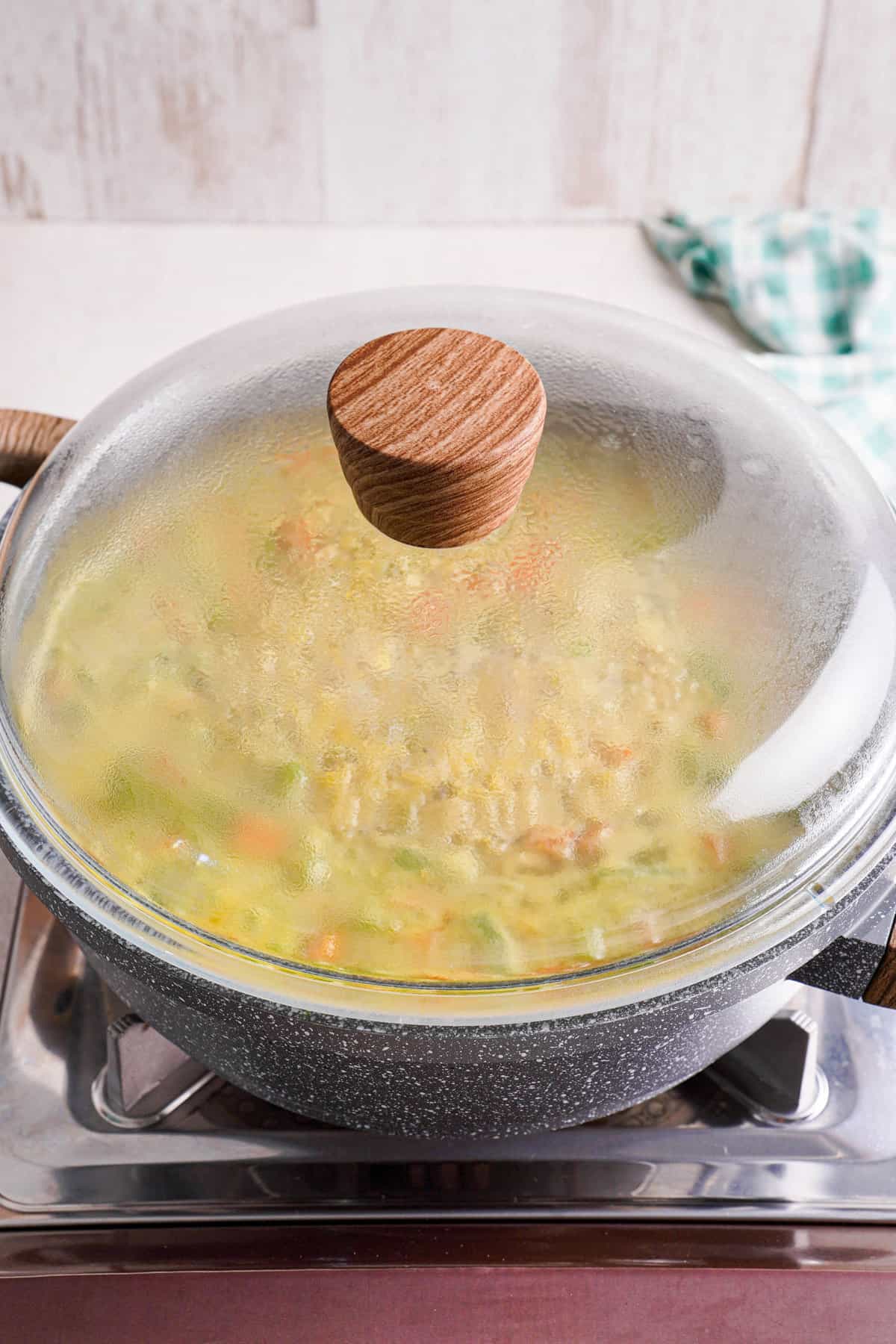
Check at the 30 minute mark to see if the rice and lentils are cooked through and the dish has a porridge like consistency.
If it's done, you can remove the dish from heat. If not, continue to cook and check in 5 minute increments until cooked.
Adjust salt to your taste (if needed), and garnish with fresh cilantro. Serve hot!
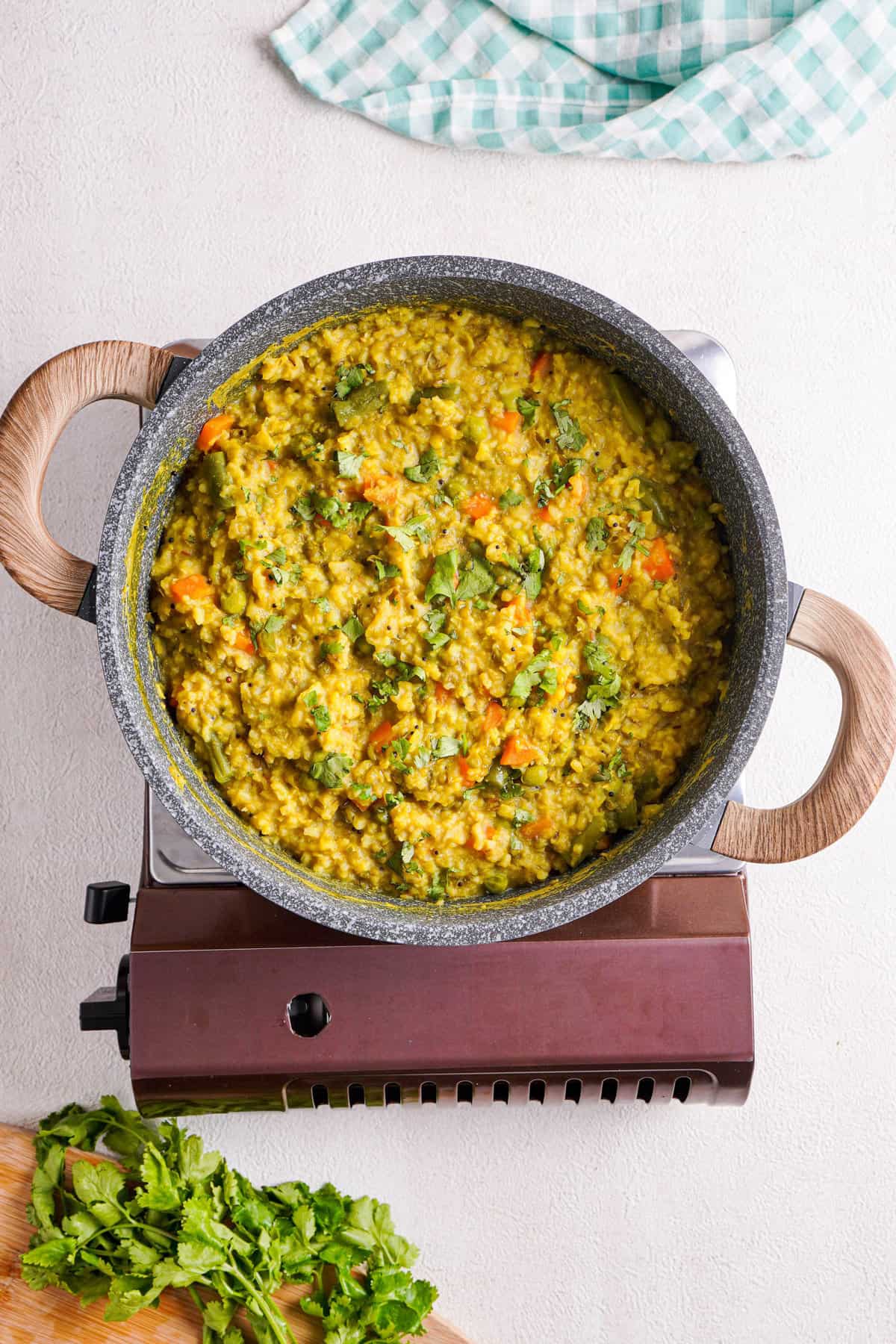
📖 Low FODMAP Kitchari
Many folks love a traditional ayurvedic kitchari recipe because it is naturally low FODMAP. However, it's important to keep a few guidelines in mind if you intend to use kitchari this way and consult your healthcare provider before doing so.
- Substitute mung dal with urad dal - according to the Monash University's FODMAP app, chana and urad dals (as well as canned lentils) are considered low FODMAP.
- If you are trying to add more flavor by using vegetable broth, please be aware that many vegetarian or vegan broths contain garlic and onion. So, to keep this truly Ayurvedic and low FODMAP, I suggest using only water. Alternatively, you can use a low FODMAP soup base (which is not Ayurvedic).
- Premade kitchari spices, though convenient, often contain asafetida (hing) instead of onion or garlic. But most asafetida has gluten in it. If you want to use hing and follow either Ayurvedic or low FODMAP protocols, I suggest picking up a brand like this one (which is gluten free).
📖 Instant Pot Kitchari Recipe
It is very easy to make this recipe in an Instant Pot or pressure cooker. In fact, Instant Pot or pressure cooker kitchari makes the process all the more easier!
- Start by washing the rice and mung dal until the water runs clear (just like the stovetop version).
- Then, set your Instant Pot to the sauté setting. Add oil of choice followed by mustard seeds, cumin seeds and ground coriander. Stir a bit to release the natural flavors of the spices (about a minute). Then, add the minced ginger and turmeric and stir to combine.
- Next, add washed rice, mung dal, along with a cup of vegetables of your choice as well as 3.5 to 4 cups of water. Close the lid and pressure cook on high pressure for roughly 8 minutes for a well cooked porridge-like consistency. Then, quick release pressure after 5 minutes. Garnish with fresh cilantro and serve hot!
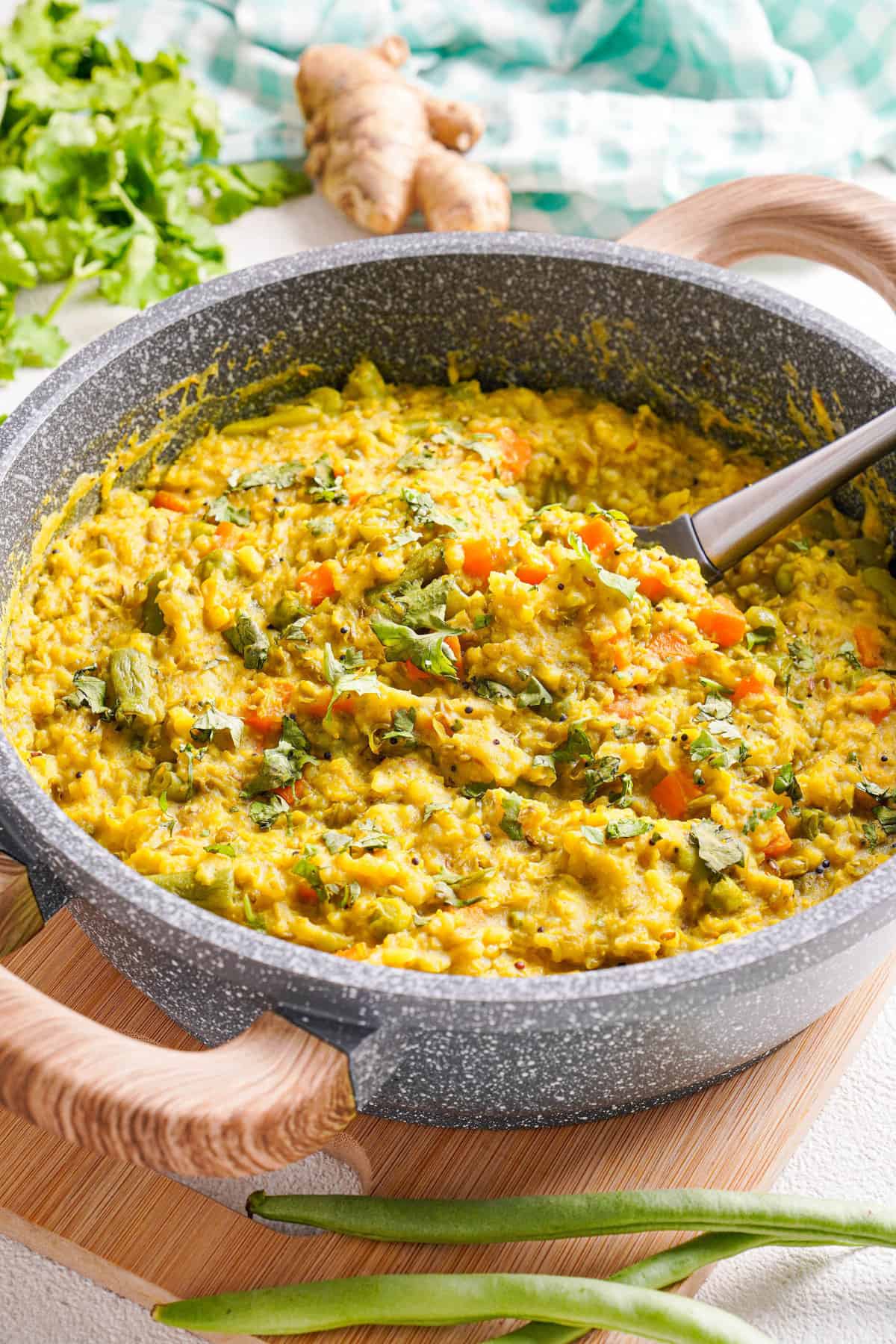
Note: if you're using an Instant Pot to make kitchari, it will be more porridge-like. Do not reduce the water in this instance, since Instant Pot uses steam and pressure cooking and reducing the water might burn the bottom of your food!
👩🏽🍳 The Kitchari Cleanse
Though kitchari has its stronghold in ancient Indian tradition, it has been made wildly popular these days due to the Kitchari Cleanse.
I'm not a fan of fad diets and cleanses generally, but the kitchari cleanse is basically what we did at home anytime we got sick (except, of course, we didn't call it that).
Modern kitchari cleanses start with a week where you cut back on sugar, coffee, alcohol and other processed foods to prepare for the cleanse.
Then, for about a week, you typically consume something high in fiber for breakfast and kitchari for both lunch and dinner as well as 8 to 10 servings of water to stay hydrated.
When I've done this in the past, I've slowly weaned off kitchari over the next few days. Pretty straightforward!
If you're interested in learning more about the Ayurvedic philosophy associated with this cleanse, and find out more about doshas, take a quiz online!
👩🏽🍳 Troubleshooting & FAQs
Kitchari is originally from India. There are many variations of kitchari from different regions of India (e.g., khichdi in Tamil Nadu, where I'm from). It's become popular in recent years due to its nutritious qualities, especially as more and more people look for healthy, clean and plant-based meals.
You can eat kitchari as a meal once every few days (or continuously for a period of up to a week as a cleanse, but the cleanse does not restrict amounts or calories). It's a balanced meal, and relatively filling. The only thing to watch out for is any reactions to consumption of a significant amount of lentils.
Yes! Kitchari is considered to be anti-inflammatory. The spices used (i.e., cumin, mustard seeds, turmeric, and ginger) are all linked to reduced inflammation. Mung dal (or moong dal), a core ingredient in kitchari, is also low glycemic - it's low in calories, and high in nutrients, fiber, and protein.
🍴 Serving and storage suggestions
Storing Kitchari: This dish is so, so easy to make a large batch for convenience. From a food safety standpoint, you can store kitchari in the fridge for up to 4 days, in an airtight container (make sure to cool it to room temperature first). Then, when you're ready to eat, just pop it in the microwave for a few.
Freezing Kitchari: If you need to store it longer-term, allow kitchari to cool to room temperature, throw it in a freezer bag or airtight container.
I suggest portioning them into individual sizes, and make sure to leave an inch of space on top since the liquids in the dish will likely expand. You can freeze it for up to 3 months!
Reheating Kitchari: When you're ready to eat it, I recommend thawing it first (either move it to the fridge the night before, or let it sit on a counter for at least an hour). Then, just go ahead and heat it up in a pot or warm in a microwave with a damp paper towel on top. Good to go!
From an Ayurvedic standpoint, leftovers are best eaten within 24 hours, since you're unlikely to feel energetic, clear and balanced after a longer time.
Check out my other healthy but comforting vegan lentil recipes:
📖 Recipe
Kitchari (Authentic, Ayurvedic)
Ingredients
- 1 tablespoon oil, vegetable oil or coconut oil preferred
- 1 teaspoon mustard seeds, optional
- 1 teaspoon cumin seeds
- 1 teaspoon ground coriander
- 1 inch ginger piece, grated (1 teaspoon of ginger paste)
- 1 teaspoon turmeric
- 1½ cups mixed vegetables, I used beans, carrots, and peas
- 1 cup moong dal, or split mung beans
- ½ cup rice, see notes
- 1 teaspoon salt, adjust to taste
- 5 cups water, see notes for adjustment
- 1 tablespoon chopped cilantro, for garnish
Instructions
- Rinse rice and dal separately at least 2-3 times to get rid of dirt and excess starch.
- Heat oil in a medium pot or deep skillet and add 1 teaspoon each of mustard seeds, cumin seeds, and ground coriander and give it a quick stir. Then, add ginger and turmeric and sauté for a few seconds.
- Add mixed vegetables of your choice and stir it together with the spices. Finally, add the the washed rice and dal along with water and a pinch of salt, and bring this to a boil.
- Then, reduce the heat, cover and simmer for roughly 30 minutes. Check at 30 minutes to observe the consistency - you ideally want a porridge like texture.
- Once the right consistency has been achieved, season with additional salt (as needed) and garish with cilantro. Serve hot.
Video
Notes
- Traditional Ayurvedic kitchari does not include aromatics like onion or garlic. If you want to add those to the dish, start by sautéing the aromatics first before adding the vegetables!
- You can use any combination of vegetables or even leave them out if you desire. I use green beans, carrots, and peas since these are the ones my mother uses.
- Note about the rice: traditional kitchari, or khichdi, tends to use non-polished rice (e.g. Sona Masoori). However, some of these rice varieties are harder to come by in the US, so basmati rice is a good substitute (though it does reduce the digestive benefits a bit since it's polished). You can also visit an Indian store to see if they have Sona Masoori.
- Note on consistency: this recipe yields a traditional porridge like consistency. If you want it to be a bit more solid, I suggest reducing the water by half a cup. I don't recommend using the Instant Pot to make a kitchari if you prefer yours more solid!
Nutrition
Note: This recipe was originally published on February 8, 2021. It was updated on March 11, 2024 with additional tips and tricks.
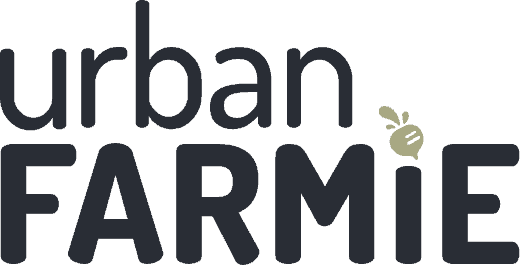














Thank you Shruti! This Kitchari was so easy to prepare and sooo delicious. I did add a little garlic and some green onion.
Thank you for all the tricks and the guidance of options to add or subtract.
Hi,
It looks very delicious!
I was wondering, do the moong dahl have another name? They look like lentils, but when I google “moong dahl” mung beans pop up as a result. They look completely different, yours look like pretty little yellow split lentils, mung beans are green and shaped like a short tic-tac.
Hi Louise! Moong dal and moong bean are technically the same variety, but moong dal is the split and peeled mung bean, commonly used in various Indian dishes. You can find moong dal on Amazon or even at a lot of regular grocery stores (but definitely in an Indian store!) Hope that helps.
Thanks for the info and tip.
Could the “ordinary” whole mung beans be used for this recipe?
I don’t believe there are any Indian stores where I live, and there’re high shipping fees with Amazon, as I’m not in a country where Amazon has a branch.
No worries! Yes, you can use the mung beans for this recipe, but I would recommend soaking it for at least 15 minutes before you make the recipe (since they typically take longer to cook than the dal!) Let me know how it goes!
Hi. This looks delicious, and I want to try it with brown rice in my Instant Pot. I have brown basmati and brown CalRose rice. Which of these rices would be best, and what would the timing be? Would I also need to increase the liquid?
Thank you in advance for your help.
Hi Pam - brown basmati rice should work in this recipe! Typically, with brown rice, I suggest soaking for 15 minutes, draining all that water, and then using that soaked rice to cook in the Instant Pot. I have found that high pressure for ~12 minutes works well. But depending on the age of the rice, you might want to cook up to 4-5 minutes longer. I suggest allowing natural pressure release after 12 minutes (or quick release after, say, 5-7 minutes). Hope this helps and hope you love it!
I loved the spice blend in this Indian porridge. It was the perfect comfort food for lunch.
I used quinoa in this recipe since we ran out of basmati rice, I'm glad it still turned out well! It was packed with flavors and so pleasing. I'm impressed!
What a comforting dish! I loved the spices in it and the house smelled so good when it was cooking. I added a few extra veg - delish!
This kitchari is a bowl full of comfort! I'm always looking for ways to bump up my turmeric intake too and this hit the spot.
I did an ayurvedic "detox" cleanse kind of diet a few years back and fell in love with kitchari during it. This is probably the best recipe I've made since!
I've been trying to learn a LOT more about Indian recipes, trying to identify spices and flavors by taste testing everything and really thinking about what I am tasting. I loved trying this kitchari out. I hadn't had it before, but I loved how simple this recipe was to follow and that I could play with the spices as I was making it. Also, just taking a personal victory of not burning the rice (for a change)!
Hi, love this recipe so much, it's so simple but yummy. Just one thing, what is an individual serving size? I assumed 2 cups for one person??
I usually do 1-2 cups!
Absolutely love the spice blend in this dish! It comes out warming and comforting and you just KNOW it's healing. Plus, it's pretty easy to whip up so mega win!
I made this with fresh Swiss chard from my garden and it was so good! Thanks for the recipe, I'll be making it again,
Hi, this was my first time making Kitchari and with your easy to follow instructions and helpful information, it turned out great. While this was the first time to make it, it certainly won't be the last.
This is really easy to follow, loved this kitchari recipe! It's really tasty and very flavorful! Will surely have this again! Highly recommended!
Hi Shruthi,
Thank you for the helpful recipe. Kitchari is often a favourite of mine!
One thing to mention though if I may?
Leftovers would probably be better eaten within 24 hours as apposed to within four days.
From personal experience and my more recent studies of Ayurveda, tamas really does begin to set in after the meal is prepared and whilst someone isn’t likely to get food poisoning from eating eating something a few days old, they’re also unlikely to feel energetic, clear and balanced either.
Just some food for thought for your fellow readers perhaps. I know it has been the case in my experience and Ayurvedic guidelines seem to indicate the same.
Best wishes.
Hi Warren - thank you so much, that's a great point. The 4 days is more of a food safety consideration than an Ayurvedic one, but I can make a note in the recipe about the point you've raised. Many thanks.
I made this (instant pot version) without any veggies this morning because I wanted to taste the base flavors. I liked it very much although it definitely needs more salt and perhaps some heat for my palate. I will definitely make this again and will likely use Better Than Boullion vegetable stock rather than plain water. Thank you for making this simple to understand!
Hey Bob! Thanks for sharing and for taking the time to share the tips on using Better than Bouillon / more salt! The version as written is intended to also be used in cleanses / true to Ayurvedic form, so I typically adjust heat and salt myself too. I'll add a note reflecting your comment, and thanks again for trying and sharing!
Thank you for this! I just made your recipe and it's absolutely delicious. I added in greens and green beans from my garden for the veg and I'm excited to experiment with others next time!
Amazing! Greens and green beans are a great, nutritious addition!